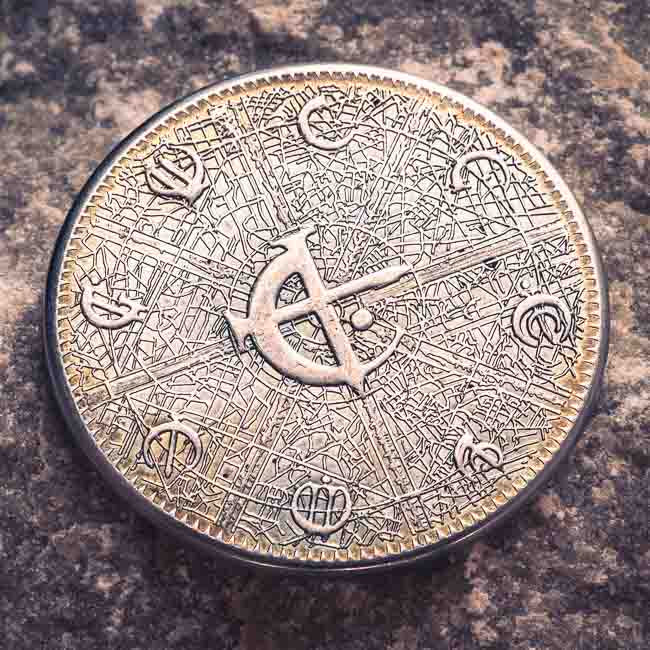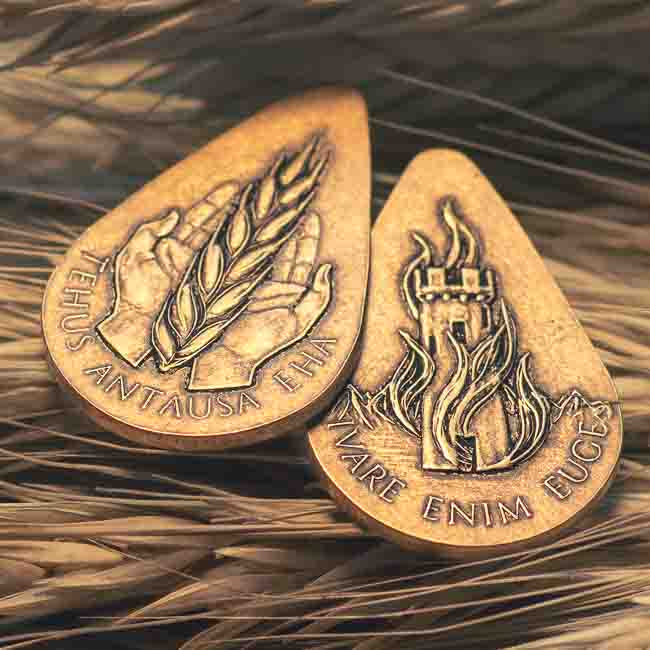The heavy flywheel is affixed to a steeply threaded triple-lead screw three inches in diameter, which is threaded into a bronze insert in the head-frame and pushes a ram down a set of fixed ways. All the energy of the spinning flywheel is thus focused upon any object placed beneath the ram. The soft metal blank placed between hard steel dies provides a perfect vessel for that energy.
All screw presses require an object to strike. Actuating a press without a blank on the dies results in a “clashing” of the dies, which will likely ruin them. All screw presses generate a strong torsion action upon striking, and therefore must be sturdily bolted to the floor to keep from walking during use.
The blue press is manual, meaning that the operator must manually raise the flywheel, and accelerate it downward for each strike. It is an arduous and back-breaking labor if carried on for very long! Typically, the upper die would be affixed to a holder on the ram, while the lower die would be stoutly held in a “die shoe” affixed to the bridge plate on the press bed. The gray machine on the right is a slightly more modern version of the screw press… a style dating to the late 19th century. This 50 tonne power press was made by the Zeh and Hahnemann company of Newark New Jersey. It is basically a screw press with a motor assist mechanism effected by a spinning horizontal shaft overhead… fitted with two clutch wheels.
On pulling the actuation lever the shaft is shifted longwise such that the right hand clutch wheel accelerates the screw downward to strike the work. On release of the lever the other clutch wheel engages and raises the flywheel and screw back up to the ready position. This press was originally designed to be run from a steam driven line-shaft, but has been retrofitted with a three horsepower three phase motor mounted on the floor behind it. The major benefit of this press style is the lesser dependence on pure muscle to operate it.


The operator is seated in front of the machine and hand-centers each blank on the lower die. A further evolution of coin-press design is represented by our Waterbury Farrel 150 tonne knuckle press, weighing some 10,000 pounds (appx 4000 kg). This design dates to the mid 19th century and rapidly became the most popular type of press for large mints. The action of the press is based on a large sidemounted flywheel with an eccentric behind. The eccentric actuates the knuckle mounted above the press-bed, moving the ram a fixed distance with each stroke. Unlike the screw presses, a knuckle press does not require a target object and may be safely actuated without a blank present. Knuckle presses, due to the double leverage nature of the mechanical connection, are more powerful than a screw press of comparable size. It takes more time and skill to set up a knuckle-press for a coining run… but there is less risk of damage to dies from clashing. This press was originally set up to be driven from a steam powered line-shaft, but was expertly converted to electric power at some point in the past. It is currently powered by the ten horsepower low-rpm three-phase motor mounted on top. Knuckle presses have little tendency to jump or walk and therefore it is not required that they be bolted to the floor.
Below is a panoramic montage showing what the workshop looks like on a typical day. From left to right: The 13×40 metal lathe used to prepare die blanks and make tooling for the presses, the blue 40 ton manual screw press, the gray 50 ton power press, the milling machine, the 5″ x 40″ heat treating furnace (looks like a gray barrel) and a pottery kiln just in front of it, in foreground below is a tool grinder for lathe bits, the green 150 ton knuckle press stands to the right, with a small bandsaw below. Further to the right are three smaller manual screw presses used for punching coin blanks. At far right is a rolling mill for rolling down metal stock, while in the foreground at far right is a 20x stereo microscope used while working on dies. Not shown in this photo is the larger 14″ bandsaw, 2 x 72 and 6 x 48 belt grinders, 2 pedestal buffers, the Gorton 3d pantomill, the precision tool grinder, and the 320 ton hydraulic press for doing large work.



